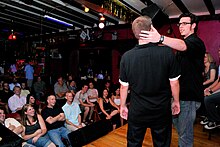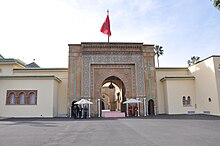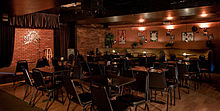Comedy club


A comedy club is a venue where a variety of comedic acts perform to a live audience. Although the term usually refers to establishments that feature stand-up comedians, it can also feature other forms of comedy such as improvisational comedians, impersonators, impressionists, magicians and ventriloquists.[1]
Some forms of comedy can have distinguished venues such as improvisational theatres, which host improv or sketch comedy, and variety clubs which may also host musical acts along with comedic acts.
History
[edit]Morocco
[edit]
The documentation of Moroccan comedy spaces traces its roots back to the 17th Century, encompassing rich performance practices like Labsat and Sultan Talba.[2] The origins of comedy clubs can be traced to Labsat, an extravagant performance arts festival, with the noteworthy milestone of the first show staged within the king's, Sultan Mohammed ibn Abd Allah, palace. The evolution continued with Sultan Tabla, a theatrical celebration that served as a precursor to more modern al-halqa. Al-halqa, characterized by storytelling circles infused with elements of humor, played a pivotal role in shaping comedy performance spaces and practices.
The period of French colonization from 1912 to 1956 marked a significant chapter in the history of comedy clubs in Morocco, having heavy influences on artistic practices.[2] Following the decline of French colonial dominance, comic theaters emerged as distinct spaces, gaining prominence in the 80s as a response to the heightened cultural interest in addressing humorous real-life concerns. The theatrical landscape saw a flourishing of comic theater, employing humor and cultural critique to entertain audiences while fostering a connection with real-life experiences.
The spaces theaters and comedy clubs provided created cultural space for a future of comedy in Morocco. Now, Moroccan comedy clubs function as important spaces for humour and cultural commentary.
Japan
[edit]The emergence of Japanese comedy clubs can be traced back to the 18th century with the establishment of Yose theatres. These early iterations were constructed for various forms of entertainment, such as Kōdan, Rōkyoku, Rakugo, and other varieties.
Over the years, a notable convergence occurred between Yose and Rakugo, with the two becoming increasingly intertwined. In contemporary times, the majority of Yose theatres exclusively feature Rakugo performances, underscoring the prevalent association between Yose theatres and this particular form of comedic storytelling.[citation needed]
Rakugo is a traditional Japanese storytelling art where a hanashika enacts stories by embodying characters through distinct voices, gestures, and wordplay. The narratives typically conclude with a punch line, referred to as "ochi," akin to the structure observed in contemporary stand-up comedy, which often utilizes punchlines and wordplay for comedic effect. In this way, Yose were the first comedy clubs hosting stand-up comedians (hanashikas) through the art of Rakugo.[3]
The first Yose theatre was organized in 1798 by Karaku Sanshotei 1st at the Shitaya-jinja Shrine in Shitaya, Tokyo. The stone monument commemorating the birthplace of Yose is located in this shrine, initially referred to as yoseba before later adopting the term "yose." Towards the end of the Edo period, multiple Yose theatres emerged, providing a primary source of entertainment in towns where options were limited.
The subsequent Meiji and Taisho eras witnessed the appearance of large-scale Yose theatres. However, with the advent of various entertainments like television, the number of visitors to Yose establishments significantly declined, leading to closures. In recent years, the dwindling interest in performance arts within Yose has resulted in the survival of only a few Yose theatres. Consequently, the overall Yose industry faces challenging business conditions as it contends with changing entertainment preferences.[citation needed]
Contemporary American-style clubs
[edit]Since the late 1960s and 70s, hundreds of comedy clubs have adopted a similar formula.
The first of these pioneers were The Improv and Dangerfield's.
The Improv opened as a coffee house in 1963, within the Hell's Kitchen neighborhood of New York City. While it hosted its first comedian in 1964, 5 years before Dangerfield's opening in 1969,[4] it only shifted into a comedy club after hours. The Improv became exclusively a comedy club over the years, before its closing in 1992.[5]
Dangerfield's was built ground-up as a comedy club in the Upper East Side of Manhattan. It closed due to the pandemic in 2020.[6]
Design
[edit]
Comedy clubs advantageously use their space to cater to their audience and create an optimal experience. Most clubs adjust their lighting to darker tones with the aim of creating anonymity in the crowd. Anonymity has the effect of producing more genuine responses in individuals, while also decreasing amount of external stress produced by being seen. The darkness factor is a key element to get the crowd feeling more relaxed in their space, especially for more controversial jokes which most comedians often make use of.[7]

Comedy clubs use low ceilings and small interior spaces to create fuller looking crowds. Low ceilings are especially important for most comedy clubs since laughter is an important part of their ambience. Laughter is proven to be contagious in humans, and low ceilings allow for the sound of laughter to bounce back from the ceilings and be heard throughout the space. In higher ceilings and bigger spaces the sound of people’s laughter vanishes almost instantly. Lower ceilings contribute to a more joyful space.[8] The bare redbrick wall of The Improv in New York, a result of the venue not having the budget to cover it with drywall, would go on to become a common design feature of comedy clubs.[9]
Comedy clubs opt for colder temperatures for multiple reasons. A main reason for colder temperature is that the comedian does not get too flushed and tired under the hot spotlights and cold room. The second and more influential effect is on the psychology of the audience; audiences become more alert and evidently more focused on the performance which usually elicits more laughter as a result.[10]
Where a venue has multiple stages, an "A Room" is typically the largest and best room, used for popular acts, while a "B Room" is for local, lesser-known performers.[11]
Notable clubs
[edit]North America
[edit]- Comedy Clubs
- Comedy Club Chains
- Improv groups
Europe
[edit]- Comedy T.V Show
- Comedy Clubs
- Comedy Club Chains
Asia
[edit]- Comedy Clubs
- Off the Wall Comedy Empire, Jerusalem, Israel
- The TakeOut Comedy Club Hong Kong
In popular culture
[edit]Comedy clubs often serve as the venue for stand-up comedy specials, where comedians are filmed at comedy clubs and theaters as they perform. These humorous spaces are also featured heavily in the show Seinfeld, where a staged comedy club serves as a vital place where the lead character, Jerry Seinfeld, performs and socializes.
See also
[edit]References
[edit]- ^ "comedy club (n.)". Oxford English Dictionary. September 2023. doi:10.1093/OED/8676521674.
- ^ a b Bassou, Mohamed; Krefting, Rebecca (2022). "The History of Moroccan Stand-Up Comedy". Punching up in Stand-Up Comedy. pp. 31–48. doi:10.4324/9781003352808-3. ISBN 978-1-00-335280-8.
- ^ Brau, Lorie (2008). Rakugo: performing comedy and cultural heritage in contemporary Tokyo. Lanham, Boulder, New York, Tronto, Plymouth, UK: Lexington Books. pp. 1–2. ISBN 978-0-7391-2245-7.
- ^ Robinson, Ray (4 October 1969). "New Club Opens On East Side". New York Amsterdam News. p. 19. ProQuest 226558350.
- ^ Rogers, John (2 December 2017). "The godfather of comedy looks back on a lifetime of laughs". AP News.
- ^ "Dangerfield's Comedy Club". dangerfields.com. Retrieved 2023-11-15.
- ^ Dawson, Joe (30 March 2018). "Who Is That? The Study of Anonymity and Behavior". APS Observer.
- ^ Thompson, Andrea (12 December 2006). "Study: Laughter Really Is Contagious". Live Science.
- ^ Risen, Clay (16 November 2022). "Budd Friedman, Who Built an Empire of Comedy Clubs, Dies at 90". The New York Times.
- ^ "How the Science of the Comedy Club Design Can Inspire You to Create a Better Space to Succeed". Peter McGraw. 13 May 2021.[self-published source?]
- ^ Wenzel, John (20 April 2016). "The 15 Best Comedy Clubs in North America". Vulture.